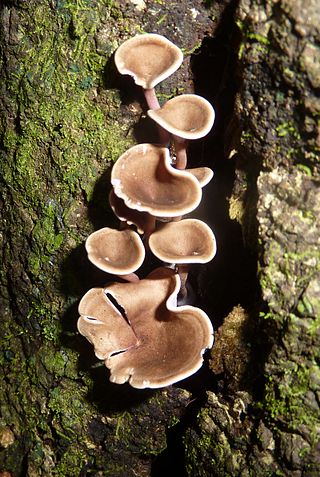| Pseudotyphula | |
|---|---|
| Scientific classification | |
| Kingdom: | |
| Phylum: | |
| Class: | |
| Order: | |
| Family: | |
| Genus: | Pseudotyphula Corner (1953) |
| Type species | |
| Pseudotyphula ochracea Corner (1953) | |
Pseudotyphula is a genus of fungus in the family Marasmiaceae. The genus is monotypic, containing the single species Pseudotyphula ochracea, found in North America. [1] The genus was circumscribed by British mycologist E.J.H. Corner in 1953. [2]

The Marasmiaceae are a family of fungi in the order Agaricales. Basidiocarps are most frequently agarics, but occasionally cyphelloid. According to a 2008 estimate, the family contained 54 genera and 1590 species, but recent molecular research, based on cladistic analysis of DNA sequences, has led to a more restricted family concept so that the Marasmiaceae now includes just 13 genera and some 1205 species.
Palaeocephala is a genus of fungi. This is a monotypic genus, containing the single species Palaeocephala cymatelloides, described by Rolf Singer in 1962. According to the Dictionary of the Fungi, the genus is classified in either the Marasmiaceae or Physalacriaceae families; the taxonomical database MycoBank includes it in the Marasmiaceae.
Calathella is a genus of fungi in the mushroom family Marasmiaceae. According to the Dictionary of the Fungi, the genus contains nine species found in Europe and North America. The genus was circumscribed by the English mycologist Derek Reid in 1964.
Cymatellopsis is a genus of fungus in the mushroom family Marasmiaceae. This is a monotypic genus, containing the single species Cymatellopsis ilmiana, found in east Africa.
Glabrocyphella is a genus of fungi in the family Marasmiaceae. The widespread genus contains 13 species.

Lactocollybia is a genus of agaric fungi in the family Marasmiaceae. The widespread genus contains 17 species, many of which are found in tropical areas.

Macrocystidia is a genus of fungus in the mushroom family Marasmiaceae. The genus contains five species that collectively have a widespread distribution.
Lecanocybe is a genus of fungus in the mushroom family Marasmiaceae. This is a monotypic genus, containing the single species Lecanocybe lateralis, found in Java and Hawaii.
Neonothopanus is a genus of three species of fungi in the agaric family Omphalotaceae. The genus was circumscribed in 1999. The type species N. nambi is found in Australia, South America, Central America, and Malaysia, while N. gardneri is found in South America. Both of these species are bioluminescent. N. hygrophanus, found in central Africa, was added to the genus in 2011.

Moniliophthora is a genus of fungi in the family Marasmiaceae. The genus was described in 1978 with M. roreri as the type species. This fungus, formerly known as Monilia roreri, causes frosty pod rot, a serious disease of Theobroma cacao.
Nochascypha is a genus of fungus in the family Marasmiaceae. The genus contains six species found in South America.
Nothopanus is a genus of fungus in the family Marasmiaceae. The genus was circumscribed by American mycologist Rolf Singer in 1944.
Phaeodepas is a genus of fungus in the family Marasmiaceae. The genus contains two species found in Venezuela.

Trogia is a genus of fungi in the family Marasmiaceae. It is named after a Swiss mycologist Jacob Gabriel Trog. The genus contains about 20 species that are widely distributed in tropical areas.
Neocampanella is a genus of fungus in the family Marasmiaceae. The genus is monotypic, containing the single species Neocampanella blastanos.
Hymenogloea is a fungal genus in the family Marasmiaceae. The genus is monotypic, containing the single species Hymenogloea riofrioi, found in tropical America.
Cymatella is a genus of fungus in the family Marasmiaceae. The genus contains four species found in the Antilles.

Campanella is a genus of fungi in the family Marasmiaceae. The genus has a widespread distribution, especially in tropical regions, and contains about 40 species.

Caripia is a fungal genus in the family Marasmiaceae. The genus is monotypic, containing the single species Caripia montagnei, commonly known as the pod parachute. It is found in tropical and subtropical regions of the Americas. Formerly classified in the Stereales, molecular analysis published in 2002 demonstrated that the fungus is a reduced form of the closely related Gymnopus.
Gerronema stevensonii is a species of agaric fungus in the family Marasmiaceae. It was first described by Miles Joseph Berkeley and Christopher Edmund Broome in 1875, calling it Cantharellus stevensonii. The fungus was named after Reverend John Stevenson, who in 1874 made the type collection in Glamis, Scotland. Roy Watling transferred the species to the genus Gerronema in 1998.